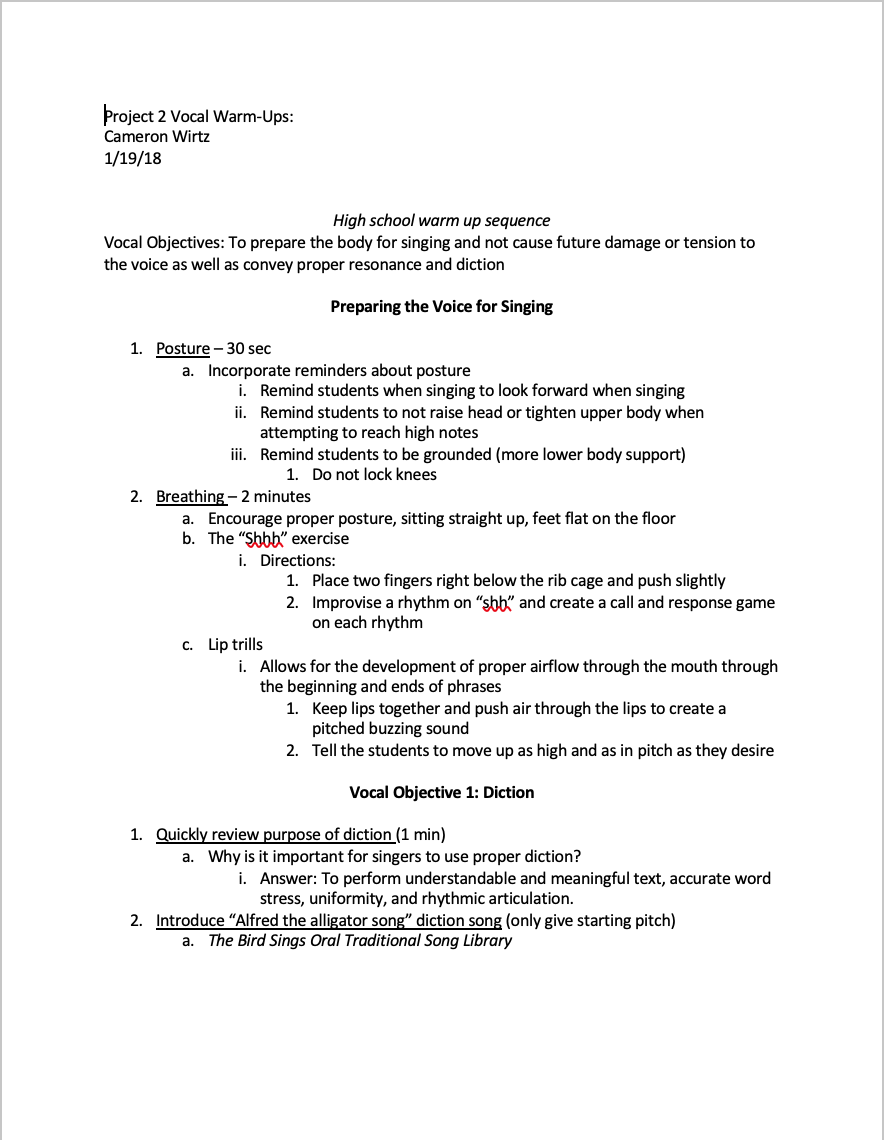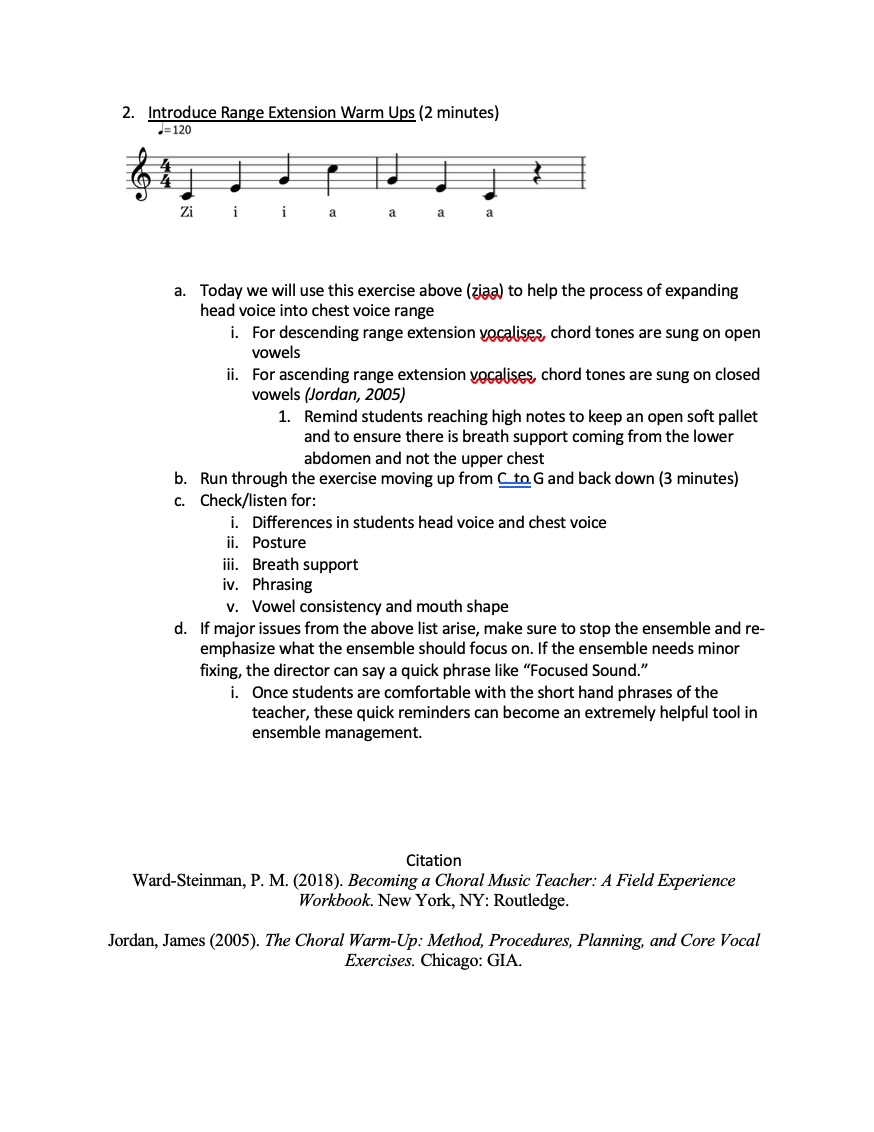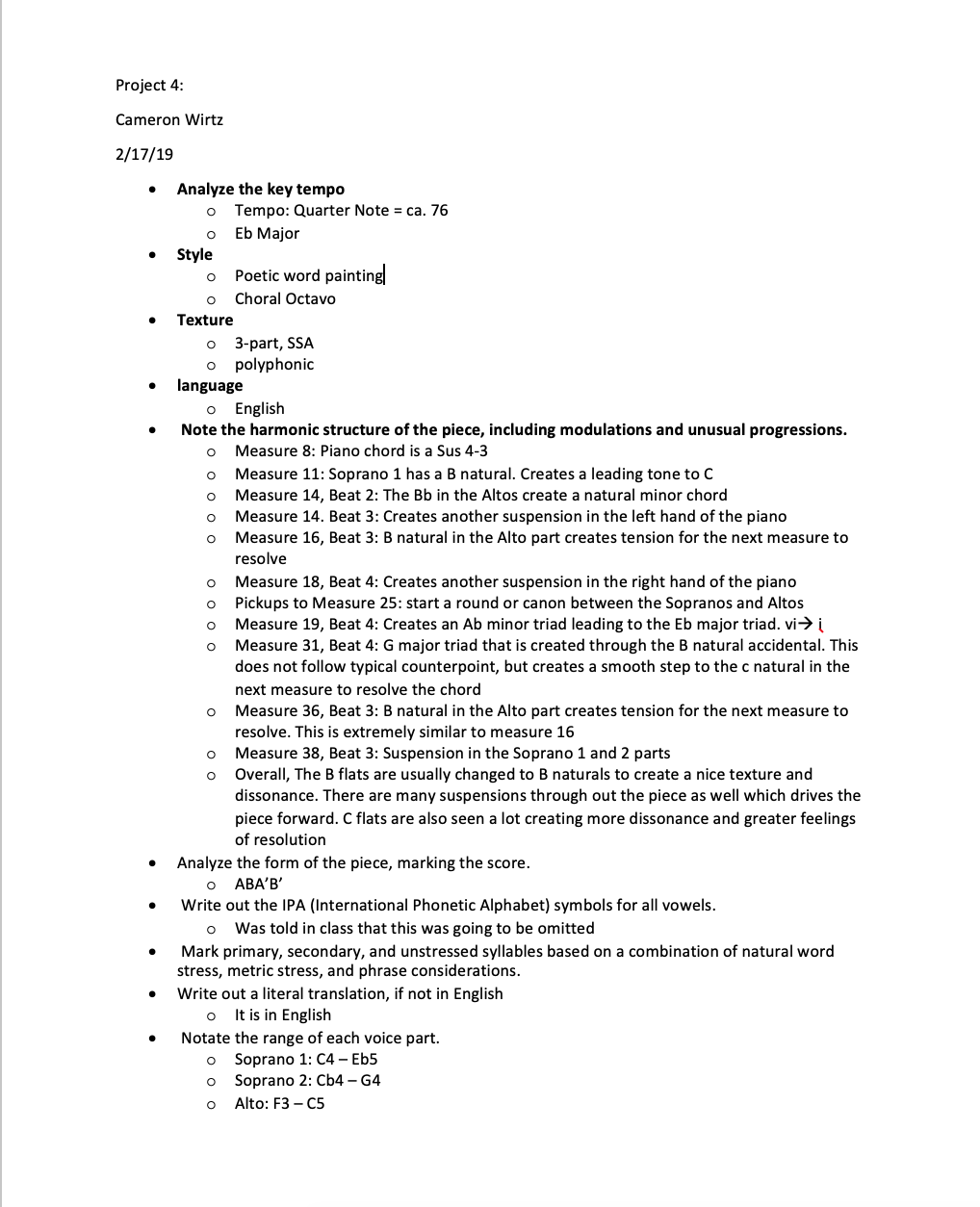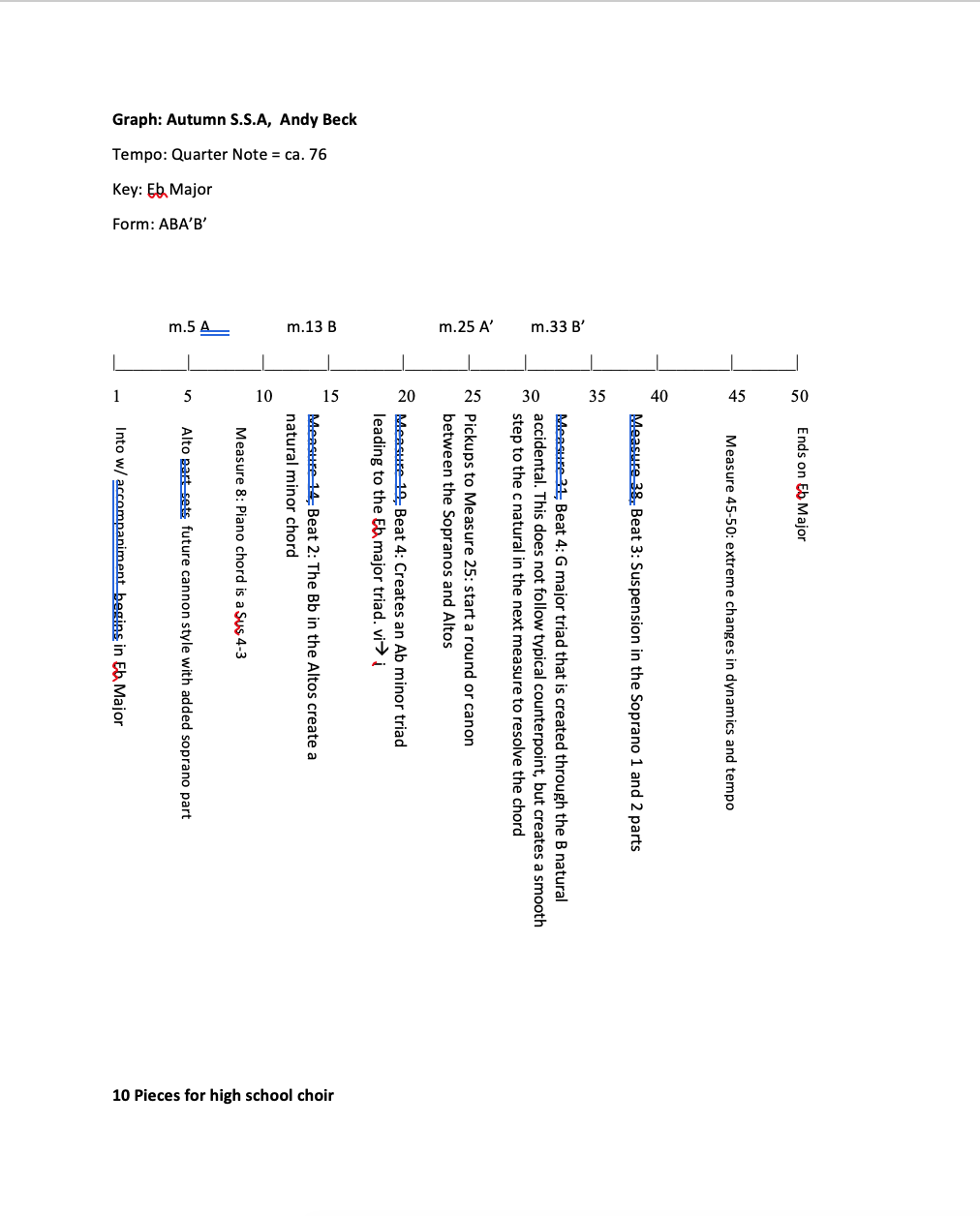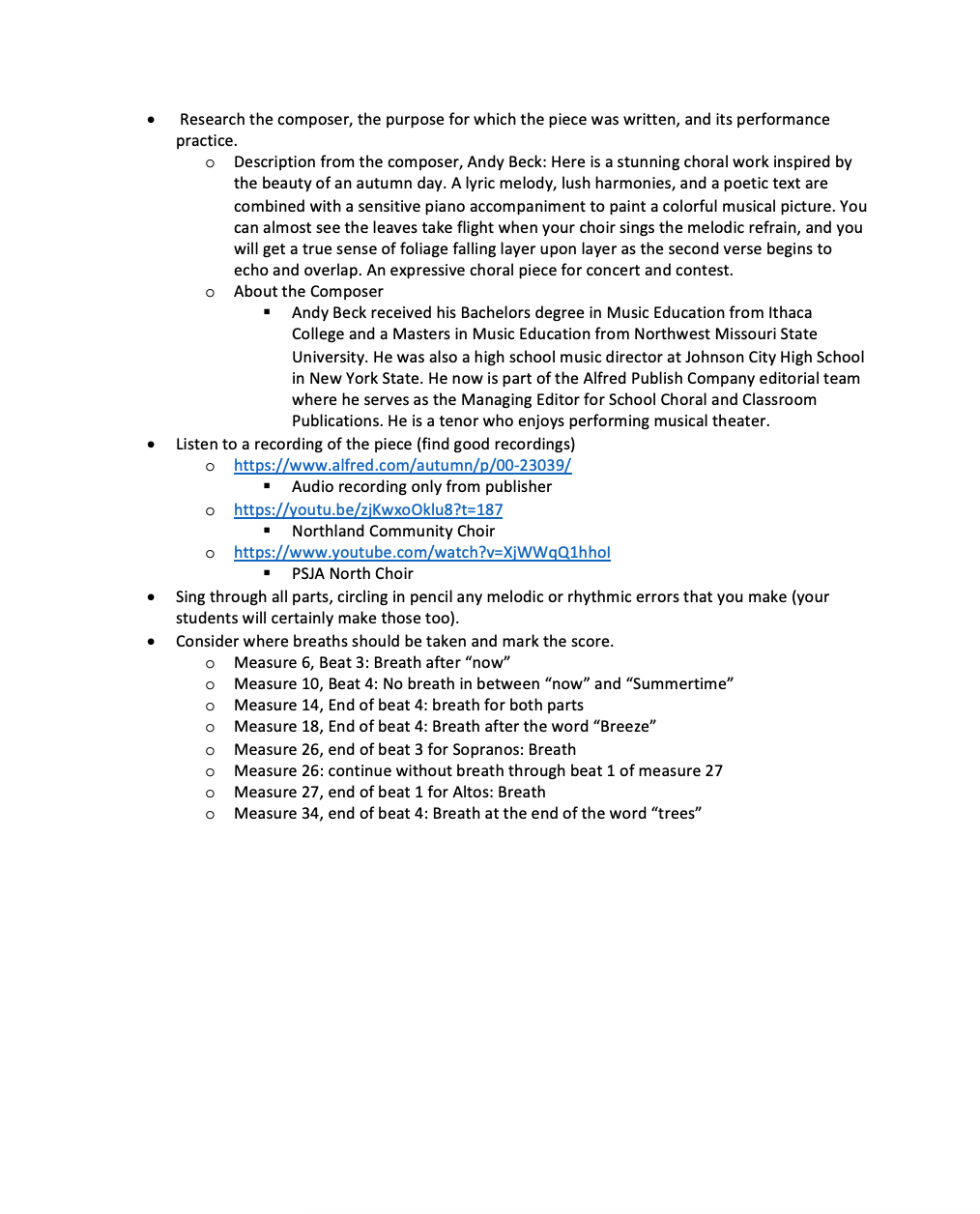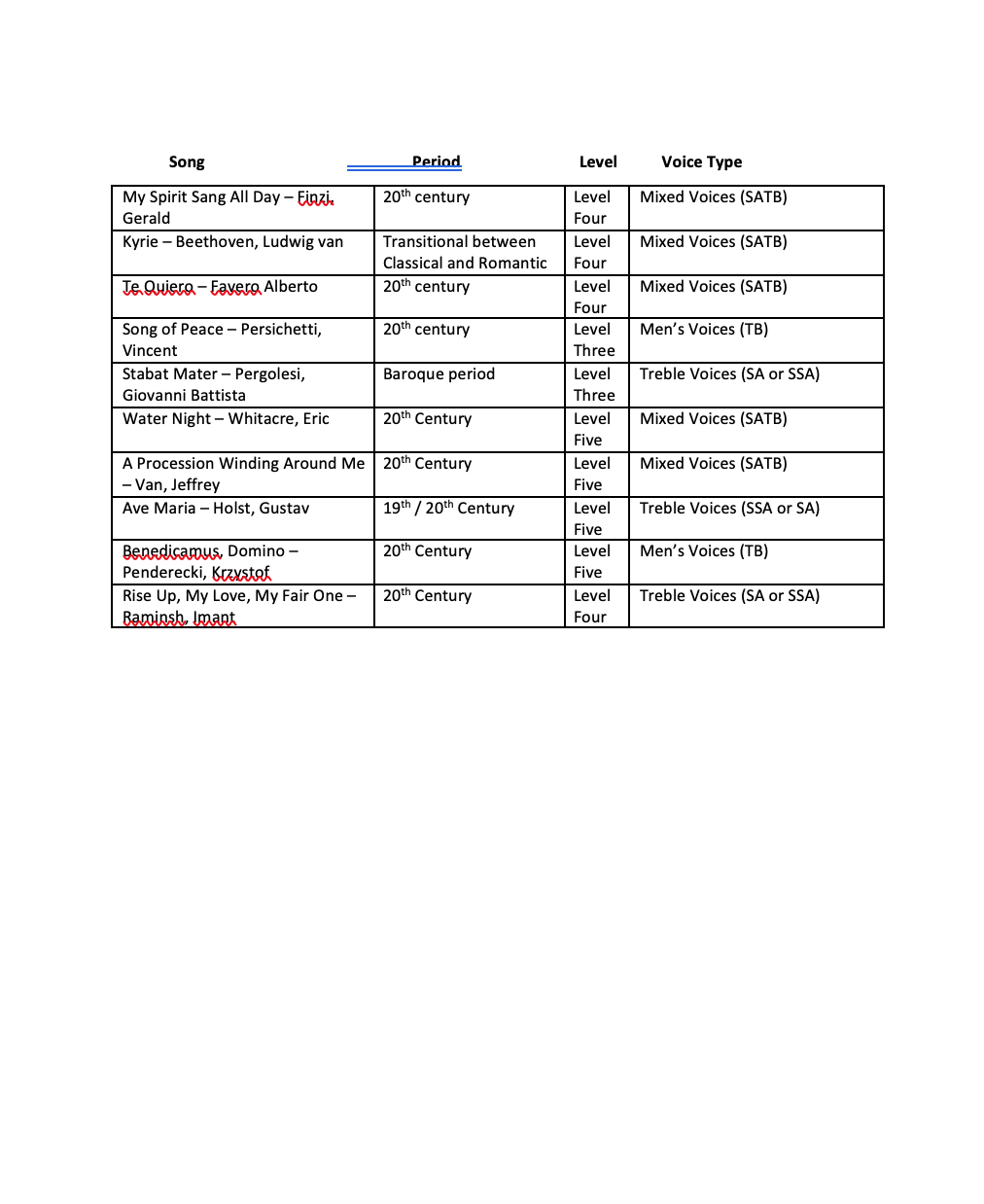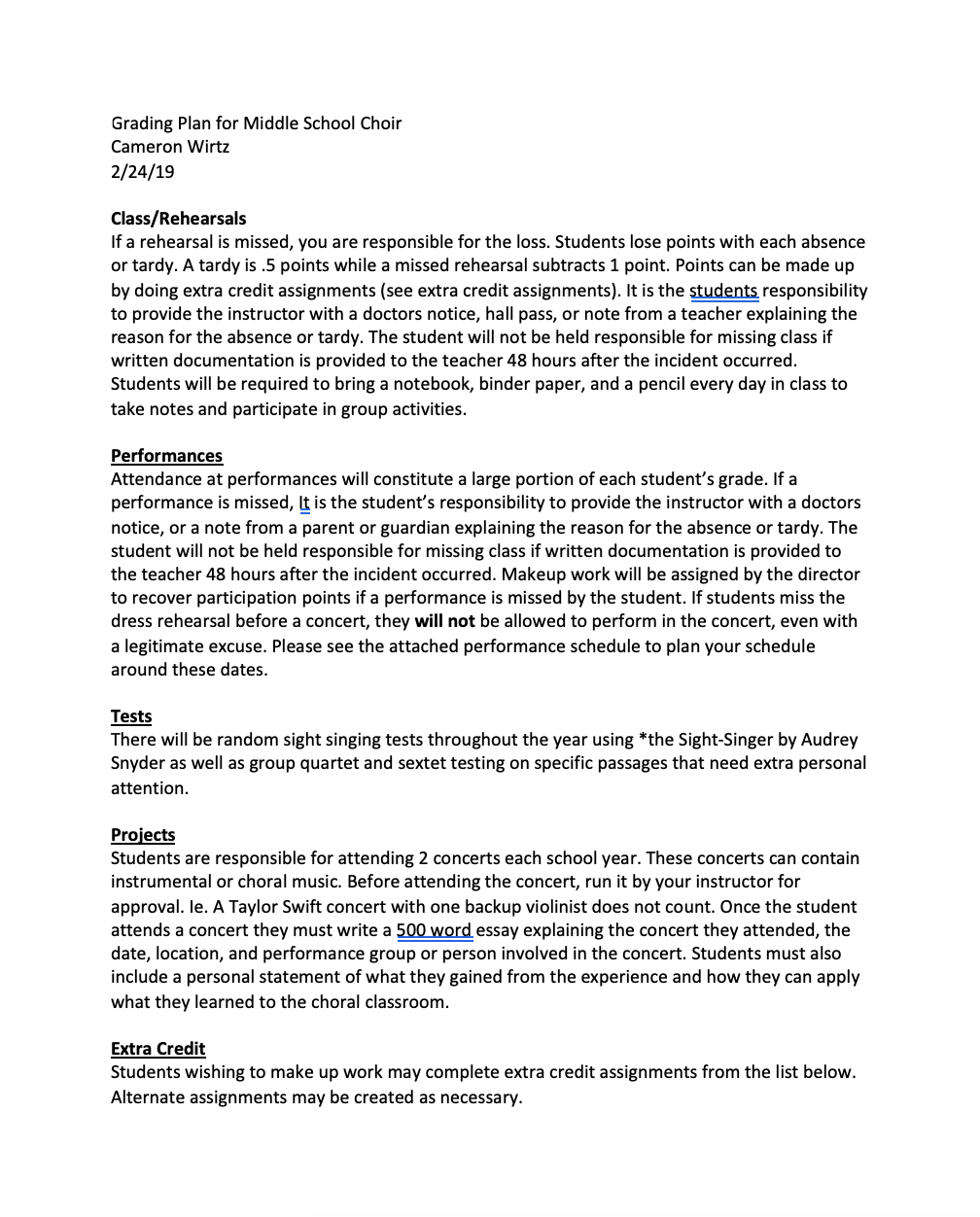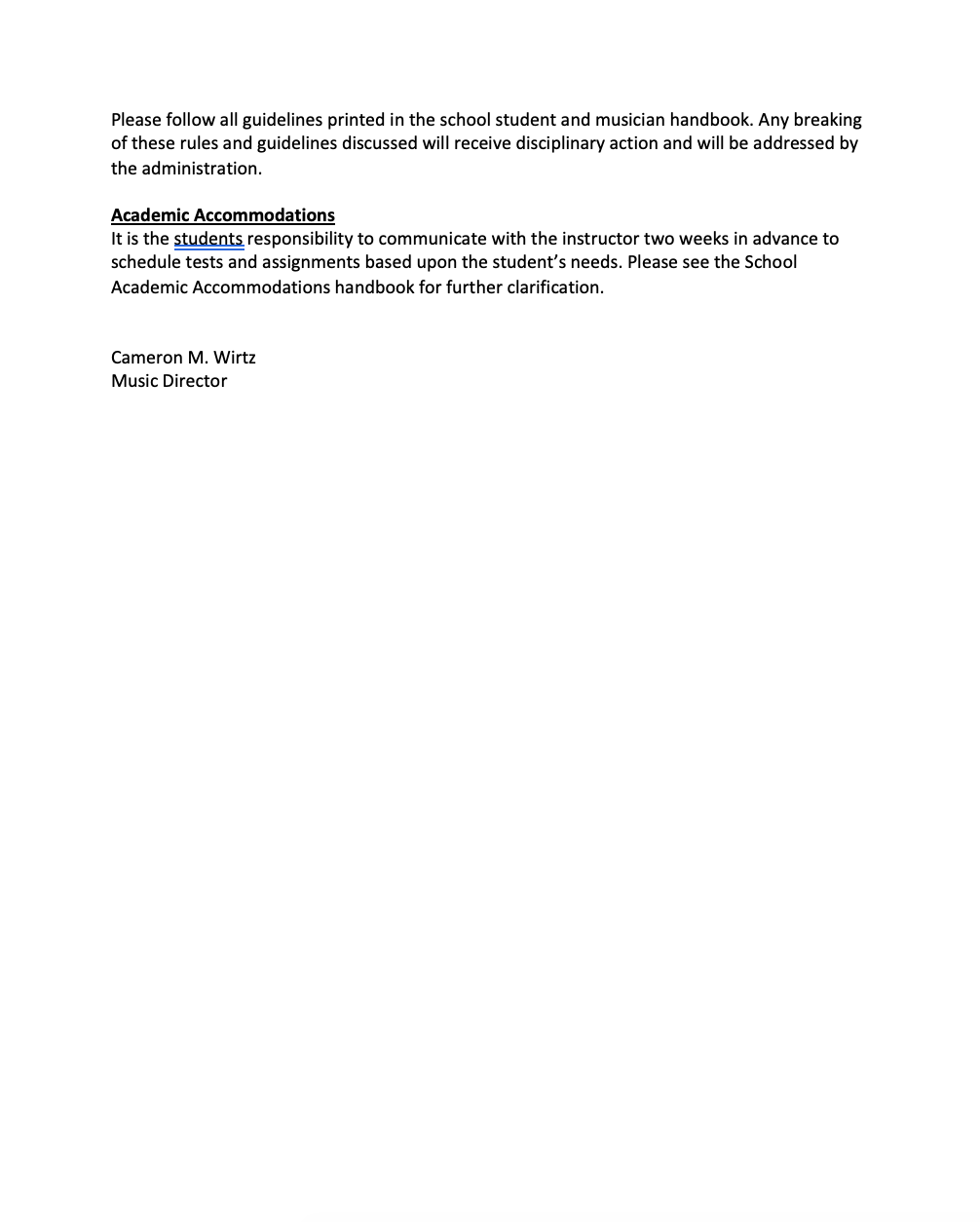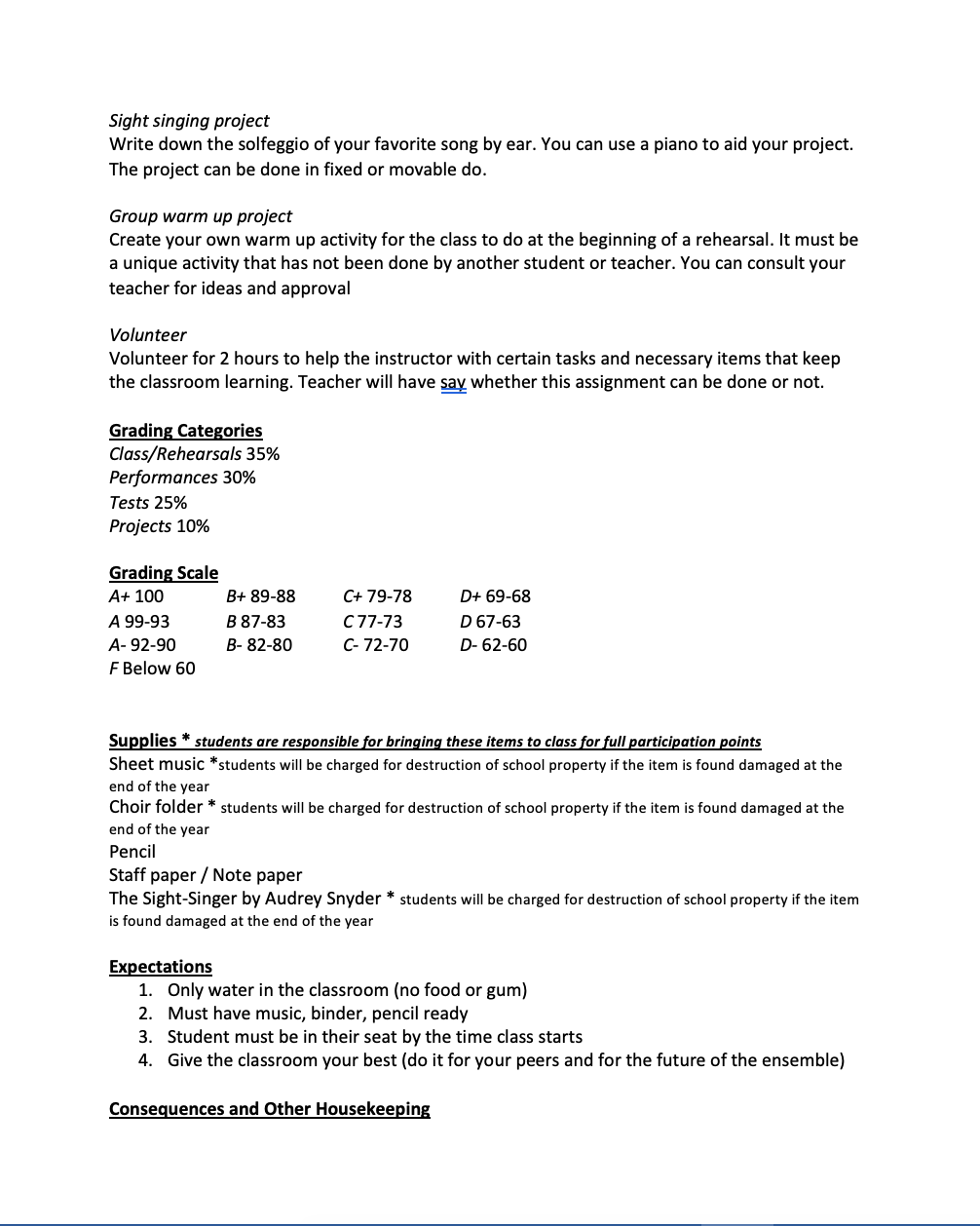Reading Reports and Projects:
Week 1: 1/9/19 Project 1: The Choir Teacher as a Comprehensive Musician; Development of Sight-Singing Skills
- List the characteristics of your must inspiring choral teachers.
- Both my high school and college choir teachers have inspirational qualities that motivate students. My high school teacher would demand excellence from her students. She had a drive and a passion to make her choir the best in the city. She was able to book venues outside of school where we could perform for the public. This gave the choir a great sense of confidence and a drive to perform well for competitions. She also had very clear conducting skills that would remind us of little details like formant shapes and character. My college choir teacher is inspirational because he is able to connect well with his students and facilitate a strong bond between the group. He is also able to command respect, while also not creating a wall between himself and the students.
- List your strengths and Weaknesses as a choral teacher
- Strengths
- Committed to Student Growth: I am good at finding the missing link to the ensemble and strengthening it to give that person or section the confidence to perform at a higher level and practice.
- Engaging: I show my enthusiasm for every piece I teach and conduct. This helps students become excited as well about the learning process. I also try and have one complement that accompanies negative comments. This helps students stay motivated while also making the tension of criticism less.
- Weaknesses
- My conducting skills kills as a choral teacher are quite lacking, as I have not had much experience conducting a choir. I hope that I can focus on choral conducting in my conducting methods class next quarter, as I already have a solid grasp of conducting orchestra and band.
- Confidence: Since I am a young teacher, I second guess myself when more experienced teachers are observing me. Some common phrases that I say to students are; “Does that make sense?” “Right?” “I think”
- Strengths
- Outline an action plan for strengthening your weaker areas, beginning today.
- Area of Study
- Choral Conducting
- Action Plan
- Watch a choral video on YouTube once a week
- Analyze the conductor
- facial expressions, cutoffs, dynamic expressions, cueing etc...
- Time Line
- 1 quarter
- Week 1-5
- Watch a video and write down 3 important conducting characteristics
- Week 6
- Go through the list of comments and pick 10 key conducting elements
- Start watching YouTube videos on those specific key conducting elements
- Week 7-10
- Draw out the conducting patterns and characteristics that you saw int eh selected YouTube video
- Week 11
- Conduct the Star Spangled Banner with a recording
- implement the 10 learned conducting elements into the Star Spangled Banner
- Conduct the Star Spangled Banner with a recording
- Week 1-5
- 1 quarter
- Assessment
- Conduct the Start Spangled Banner with a vocal recording
- Implement the 10 learned conducting elements into the Star Spangled Banner
- Conduct the Start Spangled Banner with a vocal recording
- Area of Study
|
Week 2: 1/19/19 Project 2: High School Warm Up Sequence
|
| ||
Week 2: 1/23/19 Field Visit: Lincoln Middle School Choir in Santa Monica
I really enjoyed watching Teacher (X) choir at Lincoln Middle School in Santa Monica. A student teacher began leading warm ups as Teacher (X) did attendance and played piano. She knew her students well enough to know that only two were missing. Many times when teachers take attendance it takes almost 5 minutes to complete the roster. I really appreciated how Teacher (X) was able to take role without causing a big distraction using the time efficiently to begin class.
Teacher (X) then dove into sight reading. She had a short melody projected on the whiteboard. The students were given time to look at the excerpt for a couple of minutes while Teacher (X) played chords around the tonic so that students could center themselves in the key. The student clapped the rhythm as a class, then were asked to identify triads, leaps, and jumps. The students were then given more time to audiate the song then sing the excerpt using solfeggio. I appreciated how Teacher (X) had a formula of how to approach sight reading. I had never been told how specifically to look at a new piece until college. I would like to use these sight reading approaches in my own classroom as it will help my entire ensemble straighten their musicianship skills and allow the group to work on more difficult music.
The group then worked on their pieces for their upcoming concert. I found it interesting that Teacher (X) seemed to have a mental teaching check list for herself as she always followed the same teaching patterns. For each piece she worked on she began singing what the students remembered from last rehearsal, then added solfeggio for the parts that were tricky for the students, she then isolated certain sections by having them stand and sing, and then finally used rhythmic syllables for difficult rhythmic passages in the piece. I would like to incorporate the “section standing” into my ensemble as it forces that section to be focused as well a sense of urgency and attentiveness as the rest of the class is now looking at that standing section.
At the end of class when the bell rang, the students immediately ran out of their chairs and sprinted to the door. This shocked me as I was used to students saying thank you to their teachers and allowing the teacher to finish their lesson at least to a good stopping point. It made me wonder if the students actually enjoyed what they were learning.
I really enjoyed watching Teacher (X) choir at Lincoln Middle School in Santa Monica. A student teacher began leading warm ups as Teacher (X) did attendance and played piano. She knew her students well enough to know that only two were missing. Many times when teachers take attendance it takes almost 5 minutes to complete the roster. I really appreciated how Teacher (X) was able to take role without causing a big distraction using the time efficiently to begin class.
Teacher (X) then dove into sight reading. She had a short melody projected on the whiteboard. The students were given time to look at the excerpt for a couple of minutes while Teacher (X) played chords around the tonic so that students could center themselves in the key. The student clapped the rhythm as a class, then were asked to identify triads, leaps, and jumps. The students were then given more time to audiate the song then sing the excerpt using solfeggio. I appreciated how Teacher (X) had a formula of how to approach sight reading. I had never been told how specifically to look at a new piece until college. I would like to use these sight reading approaches in my own classroom as it will help my entire ensemble straighten their musicianship skills and allow the group to work on more difficult music.
The group then worked on their pieces for their upcoming concert. I found it interesting that Teacher (X) seemed to have a mental teaching check list for herself as she always followed the same teaching patterns. For each piece she worked on she began singing what the students remembered from last rehearsal, then added solfeggio for the parts that were tricky for the students, she then isolated certain sections by having them stand and sing, and then finally used rhythmic syllables for difficult rhythmic passages in the piece. I would like to incorporate the “section standing” into my ensemble as it forces that section to be focused as well a sense of urgency and attentiveness as the rest of the class is now looking at that standing section.
At the end of class when the bell rang, the students immediately ran out of their chairs and sprinted to the door. This shocked me as I was used to students saying thank you to their teachers and allowing the teacher to finish their lesson at least to a good stopping point. It made me wonder if the students actually enjoyed what they were learning.
Week 3: 1/25/19 Project 3: Comparing and Contrasting Readings by Buchanan, Demorest, and MENC
The Buchanan reading gave a great explanation and plan of how to get to an end result of performing. It gave a plan which consisted of two smaller sections inside four large divisions. It contained its own objective, activity, and assessment. The plan it created takes more than one rehearsal to complete, so each piece could be at various stages of readiness. The reading also included strategies to engage singers in higher-order thinking and problem solving; which is a skill necessary not just in the choir classroom. The exercises in the reading also focused on using multiple parts of the brain. For example, exercises 1,3,6,8 were focused on right brain learning while exercises 2,4, 5, 7 focused on left brain. I really enjoyed reading through this as it gave me a step by step guide into how to teach. I believe this reading is most useful for the beginning choral teacher as it gives very specific guidance on how to manage a choirs progress and learning.
The Demorest reading focused on why sight reading should be taught in the classroom. It stated two factors that affected students desire to learn sight reading. One being the teachers own proficiency in sight reading and the other being an educational axiom. While this is true, it does not take much effort for the teacher to practice the exercise before class as to be more proficient than the students. The reading covered obstacles of sight-reading, but never gave specifics on how to solve the problem except for the idea to make sight reading more of a fun task. The reading also discussed the differences between systems and methods. Overall, I am not sure about who the intended audience of this book would be as many of the concepts covered seemed obvious and unnecessary to explain. I wish this reading had more of a combination of the style of the Buchanan reading, giving the reader examples and processes on how to make sight reading better for their students as opposed to just discussing the problems with sight reading in the classroom.
The MENC reading discussed aspects about choral programs such as scheduling, budgeting, and how to conduct rehearsals. I believe that choir directors sometimes forget that they cannot just be a teacher, but also an advocate for their students for school funds, concert opportunities, and decent rehearsal scheduling. Many music teachers do not have this organizational quality and thus their program is taken advantage of at school. My high school orchestral program had this issue. The teacher was never organized and because of this, other programs such as the choir, musical theater, and art departments took precedent over the orchestral program.
In general, the MENC reading was the only reading that gave real examples instead of giving advice or theoretical models. Many of the ideas stated in the MENC reading were quite obvious, such as to make sure that you are taking care of changing voices. It made me reflect on my own high school and middle school programs. For example, my middle school choir teacher did no effort to help students with their voice change. In fact, if a student asked to change voice parts, the director would tell the student that they must stick with the part they auditioned with until the end of the year. The Demorest reading also gave certain ways to teach sight reading using tools like hand signs, numbers. Much of the Demorest reading explained many of the concepts that were explored in the Buchanan reading. The Buchanan reading gave charts and step by step specifics on how to go about a rehearsal. It provided a chart which contained an objective, activity, and an assessment for each category. This reading was the most clear and concise and could easily be implemented by a teacher. There is no one method that should be used over the other, but rather each method should be used in a combination to create the best teaching and learning outcomes.
The Buchanan reading gave a great explanation and plan of how to get to an end result of performing. It gave a plan which consisted of two smaller sections inside four large divisions. It contained its own objective, activity, and assessment. The plan it created takes more than one rehearsal to complete, so each piece could be at various stages of readiness. The reading also included strategies to engage singers in higher-order thinking and problem solving; which is a skill necessary not just in the choir classroom. The exercises in the reading also focused on using multiple parts of the brain. For example, exercises 1,3,6,8 were focused on right brain learning while exercises 2,4, 5, 7 focused on left brain. I really enjoyed reading through this as it gave me a step by step guide into how to teach. I believe this reading is most useful for the beginning choral teacher as it gives very specific guidance on how to manage a choirs progress and learning.
The Demorest reading focused on why sight reading should be taught in the classroom. It stated two factors that affected students desire to learn sight reading. One being the teachers own proficiency in sight reading and the other being an educational axiom. While this is true, it does not take much effort for the teacher to practice the exercise before class as to be more proficient than the students. The reading covered obstacles of sight-reading, but never gave specifics on how to solve the problem except for the idea to make sight reading more of a fun task. The reading also discussed the differences between systems and methods. Overall, I am not sure about who the intended audience of this book would be as many of the concepts covered seemed obvious and unnecessary to explain. I wish this reading had more of a combination of the style of the Buchanan reading, giving the reader examples and processes on how to make sight reading better for their students as opposed to just discussing the problems with sight reading in the classroom.
The MENC reading discussed aspects about choral programs such as scheduling, budgeting, and how to conduct rehearsals. I believe that choir directors sometimes forget that they cannot just be a teacher, but also an advocate for their students for school funds, concert opportunities, and decent rehearsal scheduling. Many music teachers do not have this organizational quality and thus their program is taken advantage of at school. My high school orchestral program had this issue. The teacher was never organized and because of this, other programs such as the choir, musical theater, and art departments took precedent over the orchestral program.
In general, the MENC reading was the only reading that gave real examples instead of giving advice or theoretical models. Many of the ideas stated in the MENC reading were quite obvious, such as to make sure that you are taking care of changing voices. It made me reflect on my own high school and middle school programs. For example, my middle school choir teacher did no effort to help students with their voice change. In fact, if a student asked to change voice parts, the director would tell the student that they must stick with the part they auditioned with until the end of the year. The Demorest reading also gave certain ways to teach sight reading using tools like hand signs, numbers. Much of the Demorest reading explained many of the concepts that were explored in the Buchanan reading. The Buchanan reading gave charts and step by step specifics on how to go about a rehearsal. It provided a chart which contained an objective, activity, and an assessment for each category. This reading was the most clear and concise and could easily be implemented by a teacher. There is no one method that should be used over the other, but rather each method should be used in a combination to create the best teaching and learning outcomes.
| Full In Depth Outline Comparison |
Week 3: 1/25/19 Field Visit: Santa Monica High School Choir
I really enjoyed observing the Santa Monica High School choral program on January 24. The first group I observed was the all boys beginning group. They began with warmups which included stretching, lip buzzing, and chromatic warm ups on certain consonants. As the warm up progressed, the exercises became more melodic. The teacher used the piano to help bring color out of the voice, making seemingly mundane warmups more interesting and engaging. I would like to improve my level of piano to be able to accomplish this in my choir. Improvising around a simple sung warm up makes your students feel important to the ensemble and gives them encouragement to perform at a higher level.
The students then transitioned to sight reading exercises. The teacher used a combination of the Smart Music application and a touch sensitive keyboard projected on the smart board. The students were divided into teams and were given time to practice certain sight reading exercises. Each group was then called up to perform the sight reading exercise and their intonation, and tempo accuracy was checked by the smart music program. This integration of technology was extremely eye opening as I am working on a music technology application myself. The application I have created does not check students accuracy on its own, so I would like to add this feature as it seems it would be more useful for a large classroom setting.
Next, the students began working on their concert repertoire. I was a little perplexed by the teaching style of the instructor as it seemed he was facilitating dialogue on how to fix an issue rather than teaching and telling the students what to fix. Although I appreciate this method, I believe there needs to be a balance between asking questions of the students and telling the students directly what to fix. It seemed that this instructor focused too much on general questions about the piece and not enough time fixing little details. I really appreciated the teacher’s efficiency with the students as he moved from one activity to the other at a very quick pace. I believe this is extremely useful when dealing with high school students as it keeps them from talking with one another and staying focused for longer periods of time.
I really enjoyed observing the Santa Monica High School choral program on January 24. The first group I observed was the all boys beginning group. They began with warmups which included stretching, lip buzzing, and chromatic warm ups on certain consonants. As the warm up progressed, the exercises became more melodic. The teacher used the piano to help bring color out of the voice, making seemingly mundane warmups more interesting and engaging. I would like to improve my level of piano to be able to accomplish this in my choir. Improvising around a simple sung warm up makes your students feel important to the ensemble and gives them encouragement to perform at a higher level.
The students then transitioned to sight reading exercises. The teacher used a combination of the Smart Music application and a touch sensitive keyboard projected on the smart board. The students were divided into teams and were given time to practice certain sight reading exercises. Each group was then called up to perform the sight reading exercise and their intonation, and tempo accuracy was checked by the smart music program. This integration of technology was extremely eye opening as I am working on a music technology application myself. The application I have created does not check students accuracy on its own, so I would like to add this feature as it seems it would be more useful for a large classroom setting.
Next, the students began working on their concert repertoire. I was a little perplexed by the teaching style of the instructor as it seemed he was facilitating dialogue on how to fix an issue rather than teaching and telling the students what to fix. Although I appreciate this method, I believe there needs to be a balance between asking questions of the students and telling the students directly what to fix. It seemed that this instructor focused too much on general questions about the piece and not enough time fixing little details. I really appreciated the teacher’s efficiency with the students as he moved from one activity to the other at a very quick pace. I believe this is extremely useful when dealing with high school students as it keeps them from talking with one another and staying focused for longer periods of time.
Week 4: 2/2/19 Field Visit Mira Costa High School
I visited the Mira Costa High School choirs on January 31st. Overall, I was extremely impressed with the tone quality that the choirs produced. The choral program was clearly well funded, as the room was acoustically manipulated with sound deadening on the walls as well as reflective shields on the ceilings. The room also had two sound proof practice rooms. The conductor had no chairs in the room with the students only using portable stands. He would not allow students to have their jackets visible if they took them off. The conductor really wanted a tightly focused group with no room for distractions.
The students began with warm ups. The chorus sang the words “Benna Conna” using different dynamics, vibrato, articulation, and different vocal formants. I really enjoyed this quick warm up as it immediately showed the maturity of the ensemble. When the director moved his mouth a certain shape the choir immediately changed their mouth shape and a different tone was produced. During the warm up and throughout the entire rehearsal, the choral director continually paused the ensemble and turned towards his observers to ask for comments. I enjoyed being a part included verbally into his ensemble, but it took away from my ability to observe and critique on my own because I had to filter my comments that he might call upon.
During the rehearsal the choir teacher mentioned the use of the word “blend” and how it negatively impacts a choir. He stated that if you tell a choir to blend, they will listen to each other and not use their supported full tone. As a vocalist myself, I believe that as a singer matures and advances, he or she will know how to keep their voice supported without compromising tone quality. Using the word blend in a high school and college setting should not raise problems. In a middle school or lower school setting where vocal training is not in place, a teacher must explain the proper way to blend within a section.
I also really enjoyed how engaged the director was with his students. The director had his music memorized and would move about the room moving his hands and his entire body, sometimes even twirling around. I believe that twirling and moving fast across a classroom causes distraction. I would try to stand in one place in the room and still move my body with an anchor of my feet in one place. The point of standing in the center of the room as a choral director is to hear balance and connect evenly with each section. By moving around and twirling, sections will not be able to understand which gestures apply to which section and will be more focused on the directors extreme movement rather than the intention behind the movement.
I visited the Mira Costa High School choirs on January 31st. Overall, I was extremely impressed with the tone quality that the choirs produced. The choral program was clearly well funded, as the room was acoustically manipulated with sound deadening on the walls as well as reflective shields on the ceilings. The room also had two sound proof practice rooms. The conductor had no chairs in the room with the students only using portable stands. He would not allow students to have their jackets visible if they took them off. The conductor really wanted a tightly focused group with no room for distractions.
The students began with warm ups. The chorus sang the words “Benna Conna” using different dynamics, vibrato, articulation, and different vocal formants. I really enjoyed this quick warm up as it immediately showed the maturity of the ensemble. When the director moved his mouth a certain shape the choir immediately changed their mouth shape and a different tone was produced. During the warm up and throughout the entire rehearsal, the choral director continually paused the ensemble and turned towards his observers to ask for comments. I enjoyed being a part included verbally into his ensemble, but it took away from my ability to observe and critique on my own because I had to filter my comments that he might call upon.
During the rehearsal the choir teacher mentioned the use of the word “blend” and how it negatively impacts a choir. He stated that if you tell a choir to blend, they will listen to each other and not use their supported full tone. As a vocalist myself, I believe that as a singer matures and advances, he or she will know how to keep their voice supported without compromising tone quality. Using the word blend in a high school and college setting should not raise problems. In a middle school or lower school setting where vocal training is not in place, a teacher must explain the proper way to blend within a section.
I also really enjoyed how engaged the director was with his students. The director had his music memorized and would move about the room moving his hands and his entire body, sometimes even twirling around. I believe that twirling and moving fast across a classroom causes distraction. I would try to stand in one place in the room and still move my body with an anchor of my feet in one place. The point of standing in the center of the room as a choral director is to hear balance and connect evenly with each section. By moving around and twirling, sections will not be able to understand which gestures apply to which section and will be more focused on the directors extreme movement rather than the intention behind the movement.
|
Week 6: 2/17/19 Project 4
|
| ||
Week 7: 2/24/19 Teaching Refection
Last Tuesday, I coached X Middle Schools’ musical theater students. As I entered the school, I could tell that their school was quite underfunded. Their cafeteria was small, the floors of the building were beaten up, and the walls had faded paint. As we entered the theater, a group of students were greeted by a woman who asked if “we were the little student teachers?” I was taken back by this comment and quite offended, so I said nothing and moved on into the theater building. The theater showed its age. I could only imagine how well funded the rest of their music programs were.
The middle school students began with a vocal warm up. At first every student seemed interested in these activities as it was something different than they were used to, but as the same exercises dragged on, many of the middle school students disengaged. Since these students are not trained vocally, I would have done many different exercises in a short amount of time than focus on less exercises and perfect them to give the students a general feel of what the possibilities are for a vocal warm up.
The middle school students were then divided into part type and separated into different rooms. I was placed to teach lower voices. As the students gathered around the piano, I asked each student to introduce themselves. This was a great way to break the ice between a new teacher and student. I then dove right into reading the rhythms of the pieces they were performing. Unfortunately, the students did not have a score to use and only had the lyric sheet. Even if the students couldn’t read notes, I would have liked the students to have a score anyway. They could at least use the visualization of specific patterns in the music to remember phrasings, articulations, rhythms instead of not being exposed to anything.
My group needed to focus on engaging their diaphragm to produce a non-breathy sound that was supported. Some students did not even try singing. The room was extremely cold, so this could have been part of the lack of breath support and attention. I hope for next time that instead of putting 5 teachers to 15 students/ voice part, there should be 2 teachers per 5 students. Since we have the student teaching resources, we should be assigning more teachers to smaller groups for individualized attention and productivity.
Last Tuesday, I coached X Middle Schools’ musical theater students. As I entered the school, I could tell that their school was quite underfunded. Their cafeteria was small, the floors of the building were beaten up, and the walls had faded paint. As we entered the theater, a group of students were greeted by a woman who asked if “we were the little student teachers?” I was taken back by this comment and quite offended, so I said nothing and moved on into the theater building. The theater showed its age. I could only imagine how well funded the rest of their music programs were.
The middle school students began with a vocal warm up. At first every student seemed interested in these activities as it was something different than they were used to, but as the same exercises dragged on, many of the middle school students disengaged. Since these students are not trained vocally, I would have done many different exercises in a short amount of time than focus on less exercises and perfect them to give the students a general feel of what the possibilities are for a vocal warm up.
The middle school students were then divided into part type and separated into different rooms. I was placed to teach lower voices. As the students gathered around the piano, I asked each student to introduce themselves. This was a great way to break the ice between a new teacher and student. I then dove right into reading the rhythms of the pieces they were performing. Unfortunately, the students did not have a score to use and only had the lyric sheet. Even if the students couldn’t read notes, I would have liked the students to have a score anyway. They could at least use the visualization of specific patterns in the music to remember phrasings, articulations, rhythms instead of not being exposed to anything.
My group needed to focus on engaging their diaphragm to produce a non-breathy sound that was supported. Some students did not even try singing. The room was extremely cold, so this could have been part of the lack of breath support and attention. I hope for next time that instead of putting 5 teachers to 15 students/ voice part, there should be 2 teachers per 5 students. Since we have the student teaching resources, we should be assigning more teachers to smaller groups for individualized attention and productivity.
|
Week 7: 2/24/19 Project 5
|
*Please refer to Lesson Plan 1
|
Week 8: 3/2/19 Teaching Reflection
On Tuesday February 26th I student taught at X middle school. I was assigned to a group of 10 student with another student teacher were we taught music from the musical Mamma Mia. As students began to file into the room where we were going to have sections I tried to converse with the students and ask about their days and classes that they were going to have during the day. This was a great exercise to help the students be more comfortable with me and not be put on the spot answering interrogative questions. As soon as all the students entered the room, my colleague introduced herself and began introductions. From the last time we student taught at the middle school, the students had trouble with breath support. I decided that we should focus our warm up on elements that help breath support. Without explaining the exercise, I put two fingers on my diaphragm and created a pattern on “shh.” I asked the students if they noticed anything where I put my fingers. Many students replied, and I had the students repeat the same pattern I had just done. The students were quite interested in this idea and I fed off the energy giving the students the option to create their own rhythms. After this warm up, we did one more singing warm up where the students sang up on thirds using the syllables “Zi, ah, ah, ah.” After the warm ups, we moved on to the pieces they were assigned.
We asked the students to sing what they knew without any previous instruction and they were able to correctly sing the rhythm and notes. I noticed that the students struggled with the “ah ha” section as well as being confident in their entrances. My colleague and I decided to work on these concepts for the rest of the period. We kept using positive reinforcement building their confidence. I sang along with the group as well for sections that needed certain attention. The students also seemed to not work together as a unit, but as individuals. I decided to move the group in a circle so that each student could focus on each other’s mouth movement. This immediately fixed issues of confidence as well as staggered entrances.
Overall, I was extremely happy with the student’s progress. The responsiveness and excitement of the students was much higher than that of the previous week.
On Tuesday February 26th I student taught at X middle school. I was assigned to a group of 10 student with another student teacher were we taught music from the musical Mamma Mia. As students began to file into the room where we were going to have sections I tried to converse with the students and ask about their days and classes that they were going to have during the day. This was a great exercise to help the students be more comfortable with me and not be put on the spot answering interrogative questions. As soon as all the students entered the room, my colleague introduced herself and began introductions. From the last time we student taught at the middle school, the students had trouble with breath support. I decided that we should focus our warm up on elements that help breath support. Without explaining the exercise, I put two fingers on my diaphragm and created a pattern on “shh.” I asked the students if they noticed anything where I put my fingers. Many students replied, and I had the students repeat the same pattern I had just done. The students were quite interested in this idea and I fed off the energy giving the students the option to create their own rhythms. After this warm up, we did one more singing warm up where the students sang up on thirds using the syllables “Zi, ah, ah, ah.” After the warm ups, we moved on to the pieces they were assigned.
We asked the students to sing what they knew without any previous instruction and they were able to correctly sing the rhythm and notes. I noticed that the students struggled with the “ah ha” section as well as being confident in their entrances. My colleague and I decided to work on these concepts for the rest of the period. We kept using positive reinforcement building their confidence. I sang along with the group as well for sections that needed certain attention. The students also seemed to not work together as a unit, but as individuals. I decided to move the group in a circle so that each student could focus on each other’s mouth movement. This immediately fixed issues of confidence as well as staggered entrances.
Overall, I was extremely happy with the student’s progress. The responsiveness and excitement of the students was much higher than that of the previous week.
Week 9: 3/7/19 Teaching Reflection
March 7th, 2019 was the final day of teaching x middle school’s musical theater program. Out of the three days that I had taught at X middle school, this day seemed to be the most productive and beneficial to both me and the students. Because this was the third visit working with the same students, the students were able to express their needs and concerns to the teachers. This was beneficial in pinpointing areas that they struggled with in the music. The lesson began with a warm up which helped the students open their soft pallet and use falsetto. The students seemed surprised and struck when I performed an example which bridged the gap between chest voice and head voice. I sang quite high using my head voice and many students were surprised that their voices were even capable of performing the same thing. The students then tried to mimic my example and seemed to enjoy the exercise as well. Unfortunately, when the concept was applied to one of their pieces from Mama Mia, they were unable to perform the task of using their head voice. The students continued straining their voice to reach the note in their chest voice. I then reminded them of warm up exercise which they successfully performed but it did not fix the issue. My professor then gave a clue to use visual cues to help the students reach the note. I then came up with the idea of shooting a basketball using the arc hand motion. This immediately fixed the problem. The students even used the arc hand movement when the all the groups returned together from their sections. This made me very happy.
For the second sectional group warm up, I focused more on the warm up activity as they were already quite solid in knowing their music. I made the students memorize a short song called “Alfred the Alligator.” The objective for the students was to sing the song in a cannon. Using this song would affectively help the students block out other parts when they came together with the other voice parts. At first, they struggled memorizing the lyrics, but after a couple of attempts, the students had the song fully memorized and could sing it. I reminded the students to focus on intonation and tempo while singing. I spit the sectional into two three groups of 3 and cued each group when to come in. They were extremely excited and surprised to hear the exercise come to fruition, and when the sectional combined with the big group they seemed the most confident and had the ability to block out other parts to remember their own.
Overall, I really enjoyed having the experience of teaching middle school students. I really learned how to go outside of my comfort zone to teach choral methods to students who were not originally or properly trained vocally.
March 7th, 2019 was the final day of teaching x middle school’s musical theater program. Out of the three days that I had taught at X middle school, this day seemed to be the most productive and beneficial to both me and the students. Because this was the third visit working with the same students, the students were able to express their needs and concerns to the teachers. This was beneficial in pinpointing areas that they struggled with in the music. The lesson began with a warm up which helped the students open their soft pallet and use falsetto. The students seemed surprised and struck when I performed an example which bridged the gap between chest voice and head voice. I sang quite high using my head voice and many students were surprised that their voices were even capable of performing the same thing. The students then tried to mimic my example and seemed to enjoy the exercise as well. Unfortunately, when the concept was applied to one of their pieces from Mama Mia, they were unable to perform the task of using their head voice. The students continued straining their voice to reach the note in their chest voice. I then reminded them of warm up exercise which they successfully performed but it did not fix the issue. My professor then gave a clue to use visual cues to help the students reach the note. I then came up with the idea of shooting a basketball using the arc hand motion. This immediately fixed the problem. The students even used the arc hand movement when the all the groups returned together from their sections. This made me very happy.
For the second sectional group warm up, I focused more on the warm up activity as they were already quite solid in knowing their music. I made the students memorize a short song called “Alfred the Alligator.” The objective for the students was to sing the song in a cannon. Using this song would affectively help the students block out other parts when they came together with the other voice parts. At first, they struggled memorizing the lyrics, but after a couple of attempts, the students had the song fully memorized and could sing it. I reminded the students to focus on intonation and tempo while singing. I spit the sectional into two three groups of 3 and cued each group when to come in. They were extremely excited and surprised to hear the exercise come to fruition, and when the sectional combined with the big group they seemed the most confident and had the ability to block out other parts to remember their own.
Overall, I really enjoyed having the experience of teaching middle school students. I really learned how to go outside of my comfort zone to teach choral methods to students who were not originally or properly trained vocally.
